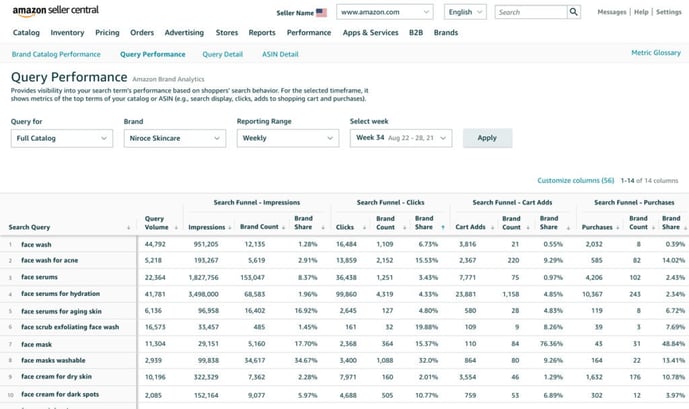RESOURCES
Seller Central Update: More Amazon Data
The holiday season is upon us, and Amazon just gave Sellers a gift at the top of their lists: search volume, sales, and competitor data launching early 2022 on Seller Central. Amazon announced two exciting platform updates at last week’s Amazon Accelerate Seminar for Sellers.
What You Need to Know
First is the new Product Opportunity Explorer tool, which can help Sellers identify new product opportunities. The second is the new Search Analytics Dashboard, which includes two dashboards that provide query and catalog performance metrics.
The insights offered in the Product Opportunity Explorer provide critical information into what customers are searching for via keywords and search volume data, what they are clicking on, buying, and not buying. The detailed data, directly from Amazon, can help retailers identify customer demand and explore product opportunities.
The tool works by evaluating “niches,” which are product subcategories. The Product Opportunity Explorer can provide data on the sales history across all Amazon Sellers associated with each niche over the past 90 days. Additionally, it includes metrics like how quickly gross merchandise sales have grown over time, the average star rating for products in the niche, whether customer interest seems to be long or short-term, and how well related searches convert to sales.
It’s possible to get into the beta of the Product Opportunity Explorer now by asking Amazon support for access.
Even More Amazon Data?
Additionally, two new dashboards, which will be free, are coming to Brand Analytics early next year. They will be offered to Sellers first, and there has been no mention of if or when Vendors would receive access to the tools at this point. Both dashboards will help Sellers better understand how customers search for and get to their products. And they will offer insight into how Sellers can more accurately optimize the sales funnel.
First, the Query Performance Dashboard shows the performance of search queries relevant to your brand, and more importantly, shows the actual search queries that led shoppers to a product. It also includes data for brand count and brand share, cart adds, purchases, and more. Organic search on Amazon has never had this level of insight before, and this dashboard is a huge opportunity for Sellers to optimize their product listings with superior accuracy.

Photo: AdWeek
The Catalog Performance Dashboard will allow Sellers to get data on impression, cart adds, and purchase data to products, offering insight into how shoppers interact with the products. The insights include impressions, price, clicks, click rate, cart adds, cart add rate, purchases, and conversion rate. The data offered in Catalog Performance will allow sellers to pinpoint conversion issues such as identifying drop-off points. It can also help with pricing strategy.

Photo: AdWeek
What Does This Mean for Your Brand?
Access to this data provides Sellers with a level of detail and offers a chance to significantly improve strategy moving into 2022. While the Product Opportunity Explorer doesn’t officially launch until 2022, it’s possible to get access to the beta simply by asking Amazon support. We’ve already begun this process, and are excited to share the data and strategic recommendations on how to use it with our clients.
Currently, many brands and Amazon agencies get search terms and product sales information from third-party tools such as JungleScout, MerchantWords, and Helium10. Having search volumes and sales information isn’t new, but third-party tools only provide estimates. Having the exact data directly from Amazon via the Product Opportunity Explorer allows brands to be much more strategic and exact in their optimization.
The Query Performance Dashboard provides many search term-related opportunities, including optimizing existing listings, broadening their keyword reach, making strategic and calculated product decisions, identifying competitors, and much more.
To prepare for the Catalog Performance Dashboard, Sellers should start thinking of how the metrics provided will help them with sales and strategy. Be prepared to incorporate this data into your monthly reporting.
As these new tools roll out, Code3 will be providing more insights and strategy recommendations. If you could use a strategic partner to navigate these changes and more, contact us today.
SIMILAR POSTS YOU MIGHT BE INTERESTED IN:
SIGN UP FOR OUR WEEKLY NEWSLETTER

News, Views, and Valuable Resources
Delivered to Your Inbox Each Week

